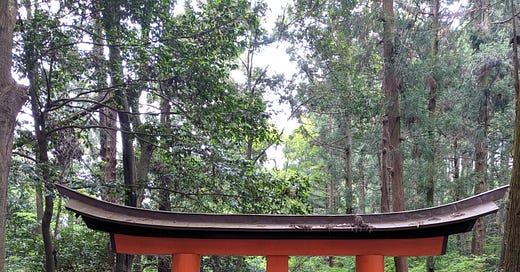Japan is unique in just how syncretic it is. In such a historically conservative and xenophobic country, you nonetheless find an astounding number of religions and life perspectives coexisting peacefully — and it's nothing new.
Syncretism, a bringing together of differences into a cogent whole, is a deeply seated motivating force in Japanese culture. It is especially stark when you see a hand-washing station and torii in front of a Buddhist temple: they appear to be completely consistent with each other, yet are from very different religions.
So what are the torii? What is a 神社【じんじゃ】jinja — a "shrine" — really? What is Shintō?
And how does it tie into Japanese syncretism?
Above is a photo I took (one of my favorites) at 伏見稲荷大社【ふしみいなりたいしゃ】 Fushimi Inari Taisha, a very large shrine devoted to a well-renowned kami who takes the form of a fox. Businesses donate here to erect torii in their name as a supplication to the kami.
鳥居【とりい】torii literally "bird roosts" are gates that mark a sacred space. When entering one, make sure to stay to one side or the other as the center path is used by kami and it is respectful not to bother them since you're entering their domain.
The word 神【かみ】kami is typically translated as "god", "deity", or "spirit" but these translations leave something to be desired simply because they bring non-Japanese connotations with them. This difference helps explain why religions such as Christianity, with its single true God, have not been accepted into Japanese culture in the same way as they have been in other countries with different religious histories.
A god, in the Western mind, is a powerful non-human entity. Outside of our control, above our ken, and mysterious. So how are kami different? At first blush they seem pretty similar. After all, kami are strange in their ways; expect barter and supplication (usually food) in exchange for working their influences; they're certainly inhuman... or are they?
There are many kami. Many many many. The phrase 八百万の神々【やおよろずのかみがみ】yaoyorozu-no-kamigami is used to describe their pantheon. It literally translates to "The Eight Hundred Myriad Kami" (a myriad being 10,000; making this 8 million) but "eight hundred myriad" is a phrase alluding to some inscrutable number; infinity, if you will.
Every kami, from the smallest all the way up to 天照大神【あまてらすおおみかみ】Amaterasu-Ōmikami (we'll come back to her later) is important in their own way. Much like every human is important in their own way. They are all unique individuals with wants, needs, emotions, relationships, obligations, and complexities. They usually take the forms of humans and animals but can be formed from and tied to plants, mountains, locations, and even manmade objects as well.
In Shintō, humans are very important. We are the catalysts and mediators. Similar to in Taoism, we stand between the Heavens and the Earth. Our role is curation, channeling, and balancing. Kami are made by, and many times from, people. Supplication, ritual, recognition, and attention are what grant the kami their might. It is not a one-sided gift for the kami to grant a wish in exchange for naught but a rice ball, it is a recognition of the important ritual of mutual exchange and an honoring of the balance of responsibilities.
Many of the kami were originally people. Japan is known as an "ancestor worship" country, where the deceased are prayed to and regularly recognized. But it goes deeper than that. It used to be more common than it is now (a lot of death ceremonies these days are Buddhist in nature) but in the Shintō tradition, a person would be given a post-humous name and given a shrine; maybe just a small one in the home (this is also part of Japanese Buddhism as it comes to them from Chinese Buddhism which added it as an accession to Confucian values but that's another story), but if they were a great person well revered then maybe they would get a more prominent one. This enshrinement and name-giving not only prevents the person from becoming a ghost (which is good) but gives them the status as kami. So long as they are remembered, they will remain. By the human power, anything from a beloved pair of chopsticks all the way up to a respected emperor can become kami. Even the aforementioned Amaterasu-Ōmikami, the kami of the sun and the one considered to be foremost among all kami was likely a normal human woman. Way, way back then, in a time long past.
This, to me, helps explain Japanese syncretism. Their willingness to accept so many different things into their culture, to take the exotic and make it their own, to see so many things on equal footing.





